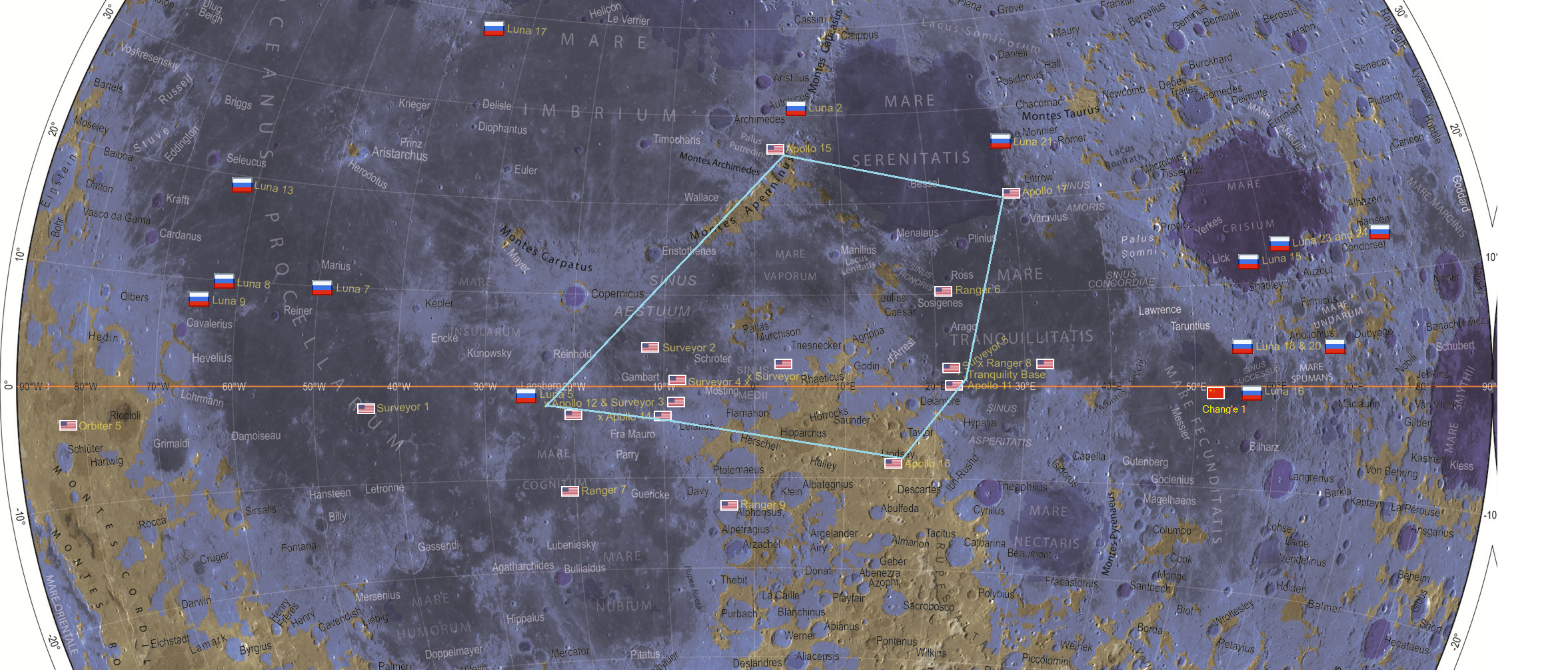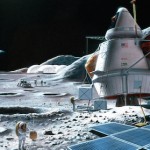This is part of an article series on India in the Global Commons. Click here to read the entire collection.

Image 1: The NASA Apollo Programme (1968-1972) landing sites encircling the region of Sinus Medii which is the centre of the near-side of the Moon.
Image Credits: NASA/Planetary Data System/Lunar Reconnaissance Orbiter Camera/Arizona State University/Lunar Reconnaissance Orbiter Team/Ralph Aeschliman
The year 2018-19 is the semi-centennial of the U.S. Apollo-11 mission (1969) when humans placed their foot on the Moon for the first time. New Delhi and Beijing – not Washington – are commemorating the golden jubilee of that epoch-making voyage by flying their robotic spacecraft, Chandrayaan-2 and Chang’e-4, to the Moon. Nations that were under-developed five decades ago now possess the capabilities to operate on the Moon. Spacecraft and other objects that have visited the Moon, and not returned to Earth during the last 50 years or so, have turned into artifacts of space-age archaeology.
Humankind has left behind almost 200 tonnes of manufactured objects on the lunar surface, some of it having been exposed to cosmic and solar radiation and other forces of nature since the last five decades. The knowledge gathered from analysing them will help galvanise scientific discoveries and also devise materials that can better withstand long-term human habitation on the Moon and elsewhere in the universe: this is an area of R&D in which many countries would like to have the edge. But if not returned to the Earth, these objects can very likely lead to nations claiming a territorial stake on the Moon.
The concept of territoriality over a global common became the basis of an unusual legislation passed by the U.S. Congress in 2013 – the Apollo Lunar Landing Legacy (AL3) Act [1]. This legislation set the foundation for the first extraterrestrial U.S. national parks. It accorded all those locations on the Moon where the Apollo mission landers and rovers crashed, soft-landed and conducted explorations, and those sites where Apollo-era objects are placed, the status of an Apollo Lunar Landing Site National Historical Park.
Space policy analysts in the U.S. have opposed this legislation as it goes against the spirit of their civilian space exploration programme and raises prickly issues about extraterrestrial ownership. They felt that their senators could instead have come up with an international agreement to preserve the properties of nations with assets on the Moon and those with the wherewithal to reach it[2].
Such opposition is futile because it does not easily effect a reversion of the Act. Moreover, it promotes geopolitical territoriality on the Moon. The artifacts should be rightly designated ‘national heritage’, but the site on which they exist be explicitly termed a ‘global common’, not a ‘national park’: support for ‘lunar national parks’ also violates Article II of the United Nations Outer Space Treaty [3]. The Moon needs to be managed, not by flag-waving, but by global consensus, prudence and realism.
This is an issue of concern as the AL3 states that “as commercial enterprises and foreign nations acquire the ability to land on the Moon it is necessary to protect the Apollo lunar landing sites for posterity,” specifically future American generations who need to view them as important constituents of U.S. history [4].
This confirms Washington’s apprehension about the increasing international footprint on the Moon. Furthermore, the legislation empowers the National Aeronautical Space Agency (NASA) and National Park Service (NPS) to manage access to the sites, coordinating with other spacefaring nations and entities where required. Some of the later Apollo missions – known as the J-phase missions – involved long-range traversing on the Moon for tens of kilometres. And if this legislation is enforced, it is likely to make this vast piece of lunar real estate a U.S. national park. Unauthorised access could result in the taking of legal measures.
If one were to join the dots between all the Apollo landing sites, these lunar ‘national parks’ enclose the region of the Sinus Medii – the centre of the near-side of the Moon which has a constant field-of-view to the Earth (see Image 1). Such a field-of-view will enable constant communications and surveillance, a strategic factor that will help the U.S. have a dominant presence on the Moon.
Laying territorial boundaries for public property, such as national parks, have political ramifications. Other nations can replicate AL3 to slyly demarcate their own territorial boundaries on the Moon, making outer space too an arena of geopolitical contestation.
The legislation also points to the possibility of the physical manipulation – amounting to mishandling – of the artifacts by robots and astronauts of lunar missions of other nations. Astronauts on the Apollo-12 (1969) mission had a close encounter with the Surveyor-3 (1967) lander. The Surveyor-3 was photographed, thoroughly monitored, and its camera, which was accidentally harbouring bacteria, was salvaged and brought back to Earth [5]. A spacecraft or crew from one nation, approaching an artifact of another, should seek to be briefed well to avoid doing inadvertent damage to the crew or equipment conducting the probe.
This could become a bone of contention because in the last 50 years, the U.S. and Russia were the only explorers of the Moon; the next 50 years will involve Indian, European, Japanese and Chinese explorers. So much international presence should be handled with care, cooperation and strategic foresight.
The decade of the 2020s will see most lunar robotic missions focus on the far side of the Moon, not visible from Earth, and the water-ice-rich regions of the lunar South Pole. Increased connectivity through sixth-generation (6G) communications networks, the ability to build light-weight and inflatable lunar space stations, and heavier cargo systems will help establish long-duration human habitation on the Moon. This will, in turn, stir healthy competition between nations, competition that will need to be regulated so that it does not turn antagonistic.
Lunar exploration and utilisation are critical to shared progress and making humankind an intelligent interplanetary species. The artifacts on the Moon must not be left on it as archaeological symbols, but be brought back to Earth, studied and the sites cleared up for missions of the future. As India’s lunar exploration programme flourishes in the 21st century it must evolve into a conscientious spacefarer, one that is able to extract dividends through science, not political territoriality.
Policymakers, nestled in the comforts that planet Earth offers, may legislate geopolitically divisive lunar policies – but the Moon’s harsh and inhospitable climes will always attract collaboration between nations, above all, in times of distress and when there is a need for rescue and recovery of crew and vital objects.
Chaitanya Giri is Fellow, Space and Ocean Studies, Gateway House.
This is part of an article series on India in the Global Commons. Click here to read the entire collection.
This article was exclusively written for Gateway House: Indian Council on Global Relations. You can read more exclusive content here.
For interview requests with the author, or for permission to republish, please contact outreach@gatewayhouse.in or 022 22023371.
© Copyright 2018 Gateway House: Indian Council on Global Relations. All rights reserved. Any unauthorized copying or reproduction is strictly prohibited.
References
[1] Retrieved from the United States Congress website, <https://www.congress.gov/bill/113th-congress/house-bill/2617/text>
[2] H.R. Hertzfeld, S.N. Pace, International Cooperation on Human Lunar Heritage, Science 342, 1049-1050. <http://science.sciencemag.org/content/342/6162/1049.full>
[3] Retrieved from the United Nations Office of Outer Space Affairs website, <http://www.unoosa.org/pdf/publications/STSPACE11E.pdf>
[4] H.R. Hertzfeld, S.N. Pace, International Cooperation on Human Lunar Heritage, Science 342, 1049-1050. <http://science.sciencemag.org/content/342/6162/1049.full>
[5] F.J. Mitchell, W.L. Ellis, Surveyor III: Bacterium isolated from lunar-retrieved TV camera. Proceedings of the Second Lunar Science Conference 3, 2721-2733. <http://adsbit.harvard.edu/cgi-bin/nph-iarticle_query?bibcode=1971LPSC….2.2721M&db_key=AST&page_ind=0&data_type=GIF&type=SCREEN_VIEW&classic=YES>


